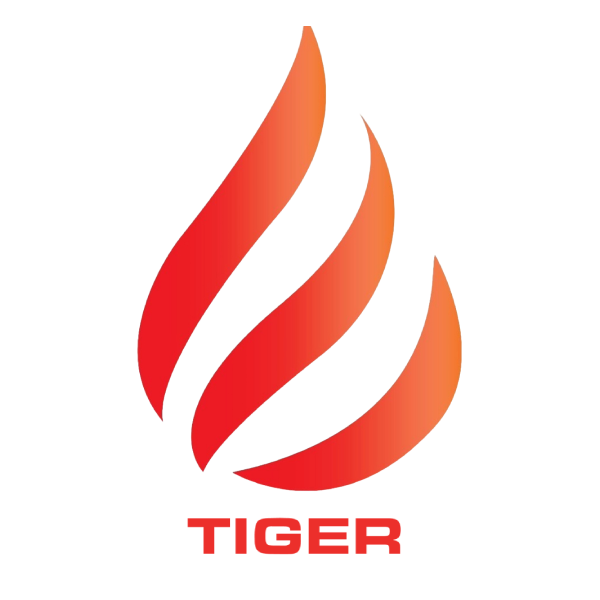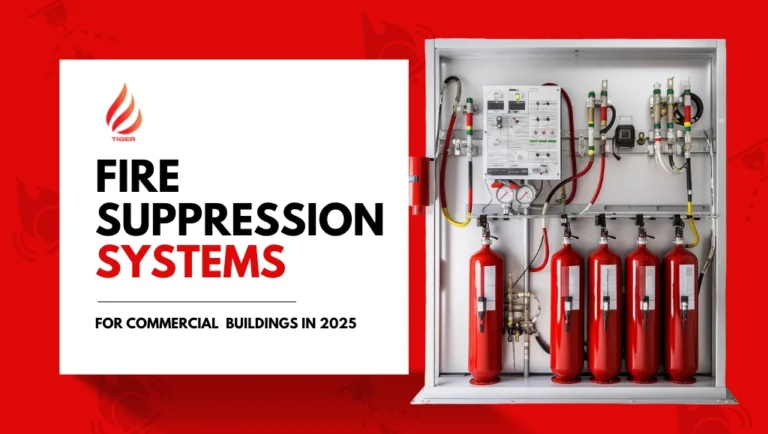In today’s rapidly evolving commercial landscape, fire suppression systems have become more than just a regulatory requirement—they’re a vital investment in business continuity, employee safety, and asset protection. As we approach 2025, the need for robust and intelligent fire suppression solutions has never been greater. Commercial buildings are facing increased electrical loads due to the rise of IoT-connected devices and the integration of EV charging stations. Architectural complexity has increased with the rise of mixed-use developments, and stricter UAE fire codes mean non-compliance can lead to heavy penalties and operational shutdowns.
Recent data from the UAE Civil Defence highlights the stakes:
- 73% of commercial fire incidents could have been mitigated with appropriate suppression systems.
- Businesses using modern suppression systems report 60% fewer insurance claims.
- On average, a fire suppression system pays for itself in 3 to 7 years through reduced fire risk and lower insurance premiums.
This guide explores the top fire suppression technologies of 2025, practical implementation strategies, and innovative solutions shaping the future of commercial fire safety in the UAE.
1. Comprehensive Guide to 2025's Top Fire Suppression Technologies
1.1 Water-Based Fire Protection Systems
Modern sprinkler systems are more intelligent and efficient than ever before. In 2025, the latest models feature micro-mist nozzles that reduce water usage by up to 50% while improving fire suppression effectiveness. Precision sprinklers now offer dual-temperature activation, allowing tailored protection for varied environments like office spaces (68°C) and warehouses (93°C).
New flow control technology allows adjustment from 5 to 100 GPM based on room temperature and occupancy sensors, reducing water waste and limiting collateral damage. For example, Dubai’s Burj Vista complex saw an 82% reduction in water damage claims after installing 2024-model variable-flow sprinklers.
Key Benefits:
- Up to 90% less water use than traditional sprinklers
- Safe for sensitive environments like server rooms and museums
- Reduces risk of mold or structural water damage
Best Applications:
- Data centers and control rooms with active electrical equipment
- Historic or culturally significant buildings
- Atriums and high-ceilinged public areas
1.2 Clean Agent/Gas-Based Systems
FM-200 systems remain a popular choice, and 2025 models now offer faster discharge times (as little as 10 seconds) and improved eco-friendly agents with zero ozone depletion potential. Advanced smart pressure sensors allow continuous monitoring for leaks or system anomalies, ensuring reliability and readiness.
Cost Analysis:
- Installation cost: AED 45–75 per sq.ft.
- Maintenance: 8–12% of install cost annually
- Lifespan: 15–20 years, making it a cost-effective long-term investment
2. Selecting the Perfect System: A Buyer's Decision Matrix
2.1 Advanced Risk Assessment Techniques
Choosing the right suppression system starts with a thorough risk assessment. Advanced tools and techniques now available in 2025 allow for more accurate evaluations:
- Hazard Mapping: Use thermal imaging and infrared sensors to identify high-risk zones.
- Occupancy Analysis: Measure peak occupancy loads to ensure sufficient evacuation time.
- Asset Valuation: Create a digital twin of your facility to map critical equipment locations.
- Fire Load Calculation: Use smart sensors to measure combustible material density per square meter.
Pro Tip: UAE regulations now require CFD (Computational Fluid Dynamics) modeling for buildings over 50,000 sq.ft., ensuring proper airflow and fire behavior simulation.
2.2 UAE Compliance Checklist
To remain compliant with Civil Defence regulations, ensure the following documentation and procedures are in place:
Required Documents:
- Civil Defence System Approval Certificate
- Valid contractor installation license
- Component material testing reports
- As-built drawings with valve and access locations
- 5-year inspection and maintenance logs
Common Pitfalls to Avoid:
- Incomplete hydraulic calculations
- Inadequate signage (missing Arabic/English translations)
- Lack of qualified service provider certifications
3. Cutting-Edge Innovations Coming in 2025
3.1 AI-Powered Predictive Protection
Artificial Intelligence is transforming fire safety from reactive to predictive. New AI-driven systems monitor data from thousands of sensors to detect irregular heat patterns, chemical changes in the air, or unusual electrical behaviors.
How It Works:
- Uses machine learning to identify fire risks before ignition
- Automatically adjusts system parameters for early suppression
- Integrates with smart building systems to initiate evacuation or shut down systems
Early Adopter Example: Emaar’s latest smart tower deployment features AI predictive systems that identified potential electrical fire risks up to 48 hours before ignition, achieving 92% accuracy.
3.2 Robotics Integration
Firefighting robots are now being integrated into commercial safety infrastructure to offer rapid response in environments unsafe for human intervention.
Deployment Strategies:
- Ceiling Drones: Act as airborne first responders to detect and suppress fires immediately
- Autonomous Crawlers: Designed to move under smoke layers and extinguish fire at the source
- Human-Assist Exoskeletons: Provide additional support to firefighters during high-rise or hazardous operations
Cost-Benefit Overview:
- Initial Cost: AED 250,000–500,000 per building
- Fire Damage Reduction: Up to 40%
- ROI Timeline: 4–6 years, especially in high-risk or large-scale properties
4. Smart Integration: Fire Suppression Meets Building Intelligence
Smart buildings of 2025 are designed with embedded intelligence that enhances fire safety. Fire suppression systems now connect with IoT sensors, HVAC, security, and lighting systems to coordinate emergency responses automatically.
Advantages:
- Immediate alerts sent to emergency services
- Smart HVAC shutoff to prevent smoke spread
- Lighting systems guide occupants to exits
This synergy improves evacuation time, reduces human error, and increases overall building resilience.
5. Workforce Preparedness: Training for Maximum Safety Impact
Even the most advanced fire suppression system requires knowledgeable personnel. Regular fire drills, system operation training, and certification courses ensure your team can respond effectively in a crisis.
Key Recommendations:
- Schedule quarterly fire safety drills
- Train maintenance staff on inspection and troubleshooting
- Partner with certified Civil Defence trainers for formal education programs
Organizations with trained staff report 45% faster response times during actual emergencies.
6. Eco-Friendly Fire Suppression: Going Green Without Compromise
Environmental considerations are increasingly important. Modern suppression systems emphasize sustainability through non-toxic agents, water conservation, and lifecycle efficiency.
Green Technology Highlights:
- Use of HFC alternatives with zero ozone impact
- Recyclable system components
- Water-efficient mist and foam systems
Investing in sustainable solutions not only meets UAE Green Building Codes but also enhances your corporate social responsibility profile.
Implementation Roadmap: Your 12-Month Plan
Phase 1: Assessment (Months 1–3)
- Conduct a detailed fire risk audit with a certified consultant
- Submit pre-approval documents to UAE Civil Defence
- Evaluate and shortlist at least three certified vendors
Phase 2: Design (Months 4–6)
- Use CFD simulations to model fire scenarios
- Finalize system components and design specifications
- Submit detailed designs for Civil Defence approval
Phase 3: Installation (Months 7–9)
- Implement in phases to avoid business disruptions
- Schedule weekly safety checks and audits
- Maintain detailed logs and installation records
Phase 4: Commissioning (Months 10–12)
- Conduct final system testing under real conditions
- Train staff on emergency procedures and system operation
- Complete the final Civil Defence inspection and certification
Conclusion:
The fire suppression systems of 2025 represent a leap forward in safety, efficiency, and intelligence. However, these systems can only offer maximum protection if properly selected, installed, and maintained. By adopting a strategic, compliant, and forward-thinking approach that includes:
- Assessing your specific fire risk profile
- Calculating the total cost of ownership
- Leveraging emerging technologies
- Adhering to UAE compliance standards

